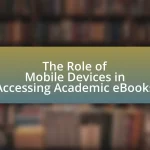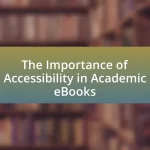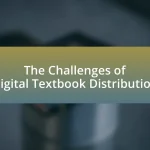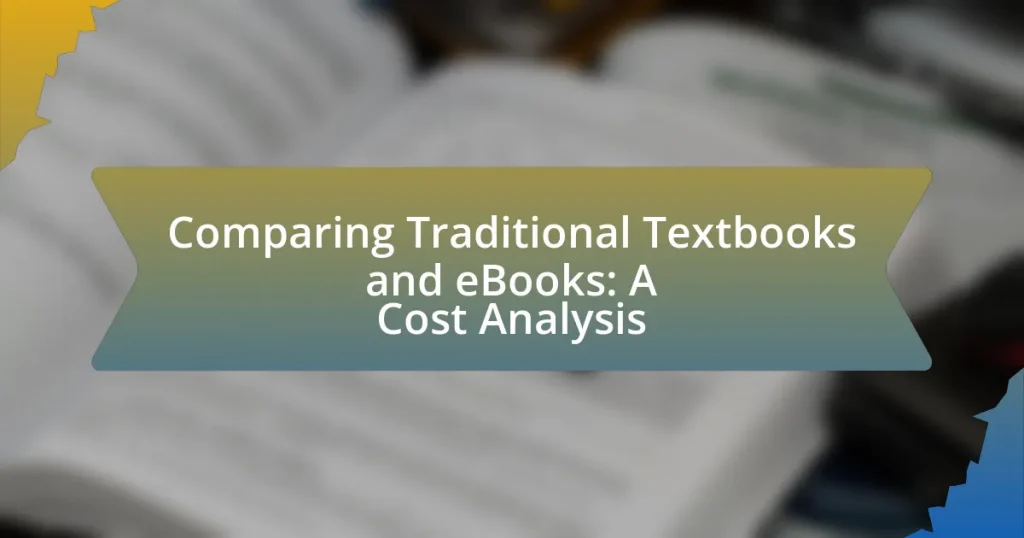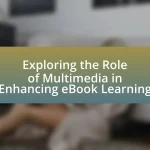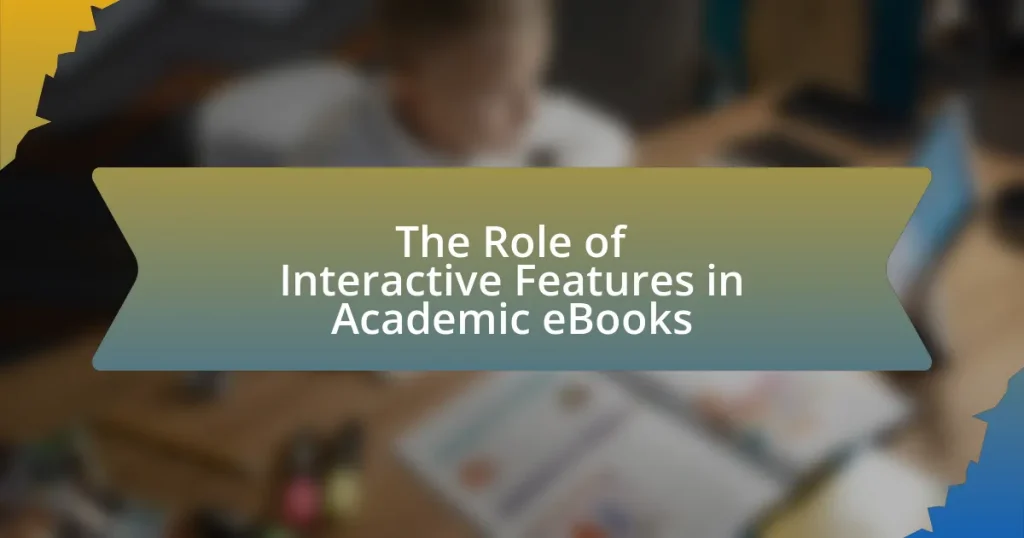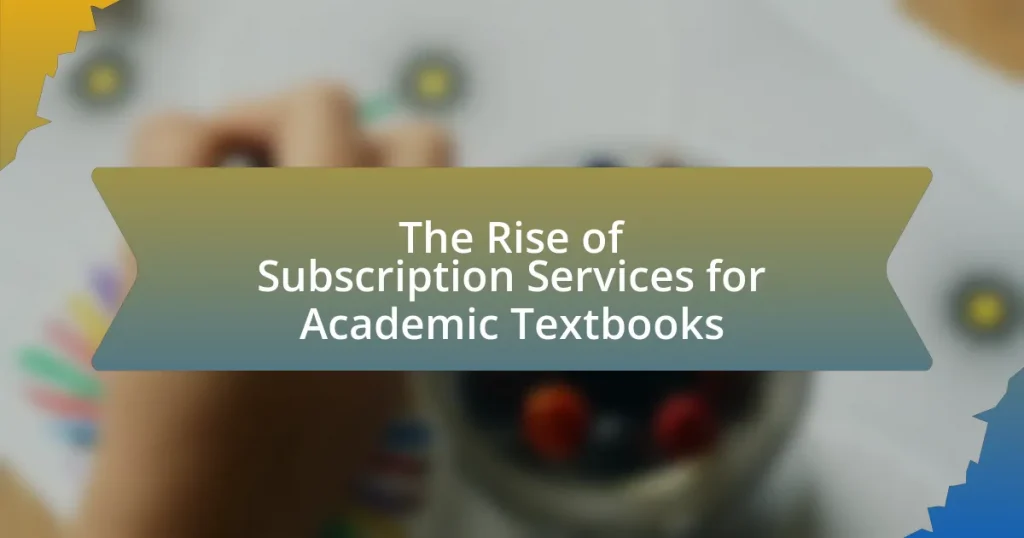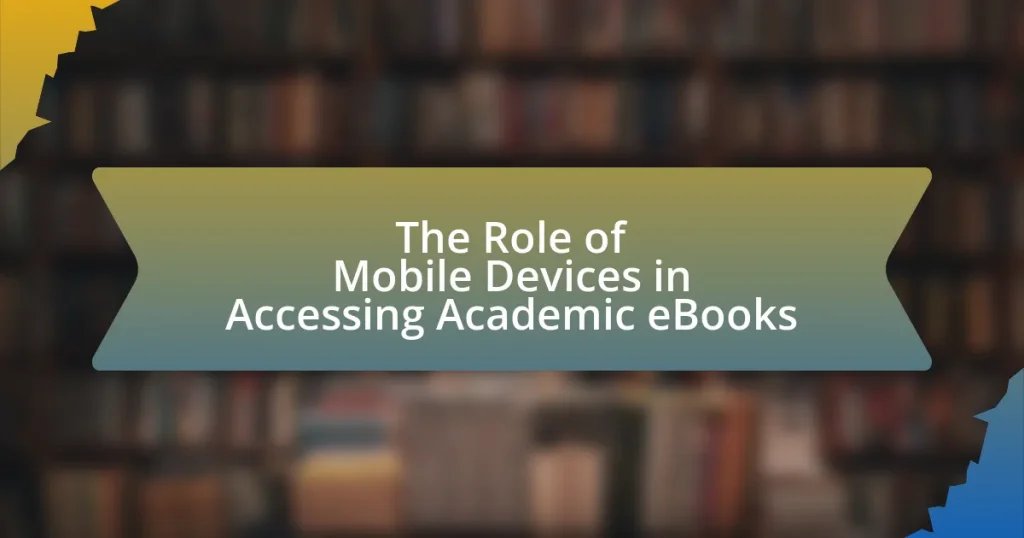The article focuses on the cost analysis of traditional textbooks compared to eBooks, highlighting key differences in production, pricing, and usage patterns. Traditional textbooks incur higher costs due to printing and distribution, while eBooks offer lower prices and the ability to update content frequently. Factors influencing pricing for both formats include production costs, author royalties, and market demand. The article also examines long-term financial implications, resale values, and hidden costs associated with each format, as well as student preferences and environmental impacts, providing a comprehensive overview of the economic considerations in educational materials.
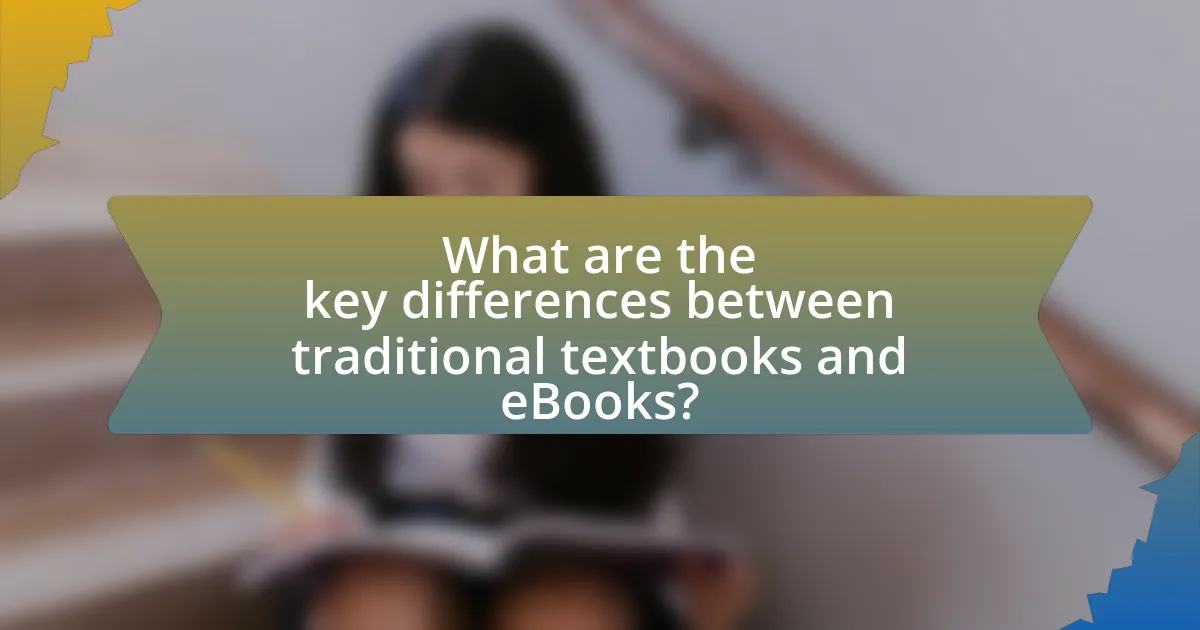
What are the key differences between traditional textbooks and eBooks?
Traditional textbooks are physical books, while eBooks are digital versions of texts. Traditional textbooks require printing, binding, and shipping, leading to higher production and distribution costs. In contrast, eBooks have lower production costs due to the absence of physical materials and can be distributed instantly online, often resulting in lower prices for consumers. Additionally, traditional textbooks cannot be easily updated, whereas eBooks can be revised and updated frequently, providing access to the most current information. This adaptability is supported by the increasing prevalence of digital platforms in education, which facilitate the rapid dissemination of updated content.
How do the costs of traditional textbooks compare to eBooks?
Traditional textbooks generally cost more than eBooks. For instance, the average price of a new college textbook can range from $100 to $200, while eBooks typically range from $30 to $80. A study by the College Board in 2021 indicated that students spend an average of $1,240 annually on textbooks and supplies, highlighting the financial burden of traditional textbooks compared to the more affordable eBook alternatives.
What factors contribute to the pricing of traditional textbooks?
The pricing of traditional textbooks is influenced by several key factors, including production costs, author royalties, market demand, and distribution expenses. Production costs encompass printing, binding, and materials, which can significantly impact the final price; for instance, high-quality paper and color printing increase costs. Author royalties, typically a percentage of sales, also contribute to pricing, as established authors may command higher fees. Market demand plays a crucial role, with textbooks for popular courses often priced higher due to increased sales volume. Lastly, distribution expenses, including shipping and retailer margins, further affect the overall cost, as these logistics must be accounted for in the final retail price.
What factors influence the pricing of eBooks?
The pricing of eBooks is influenced by factors such as production costs, market demand, author royalties, and distribution expenses. Production costs include the expenses related to formatting, editing, and cover design, which can vary significantly based on the complexity of the content. Market demand plays a crucial role, as higher demand can lead to increased prices, while lower demand may result in discounts or lower pricing strategies. Author royalties, typically a percentage of the sale price, directly affect the final price set by publishers. Additionally, distribution expenses, including platform fees charged by retailers, can impact the pricing structure, as these costs are often passed on to consumers.
What are the long-term financial implications of choosing one over the other?
Choosing eBooks over traditional textbooks generally results in lower long-term financial implications due to reduced costs associated with purchasing, storage, and updates. eBooks typically have a lower upfront purchase price, often ranging from 30% to 50% less than physical textbooks, which can lead to significant savings over time, especially for students who need multiple texts each semester. Additionally, eBooks eliminate the need for physical storage space and can be updated more easily, reducing the costs associated with buying new editions. According to a study by the National Association of College Stores, students can save an average of $300 per year by opting for digital formats, reinforcing the financial advantages of eBooks in the long run.
How do resale values differ between traditional textbooks and eBooks?
Resale values for traditional textbooks are generally higher than those for eBooks. Traditional textbooks can often be resold for 50% to 70% of their original price, depending on condition and demand, while eBooks typically have little to no resale value due to licensing restrictions that prevent transfer of ownership. For instance, a study by the National Association of College Stores found that physical textbooks retain a significant portion of their value in the resale market, whereas eBooks, which are often tied to specific accounts, cannot be resold, limiting their financial return.
What are the potential hidden costs associated with each format?
The potential hidden costs associated with traditional textbooks include shipping fees, physical storage requirements, and the depreciation of value over time, as they can become outdated quickly. For instance, students may incur additional expenses for shipping when ordering textbooks, and they may need to allocate space for storing these physical books, which can lead to costs related to storage solutions. In contrast, eBooks may have hidden costs such as subscription fees for access to platforms, potential device compatibility issues, and the need for ongoing internet access, which can lead to additional data charges. Research indicates that while eBooks often appear cheaper upfront, the cumulative costs of subscriptions and necessary technology can surpass those of traditional textbooks over time.
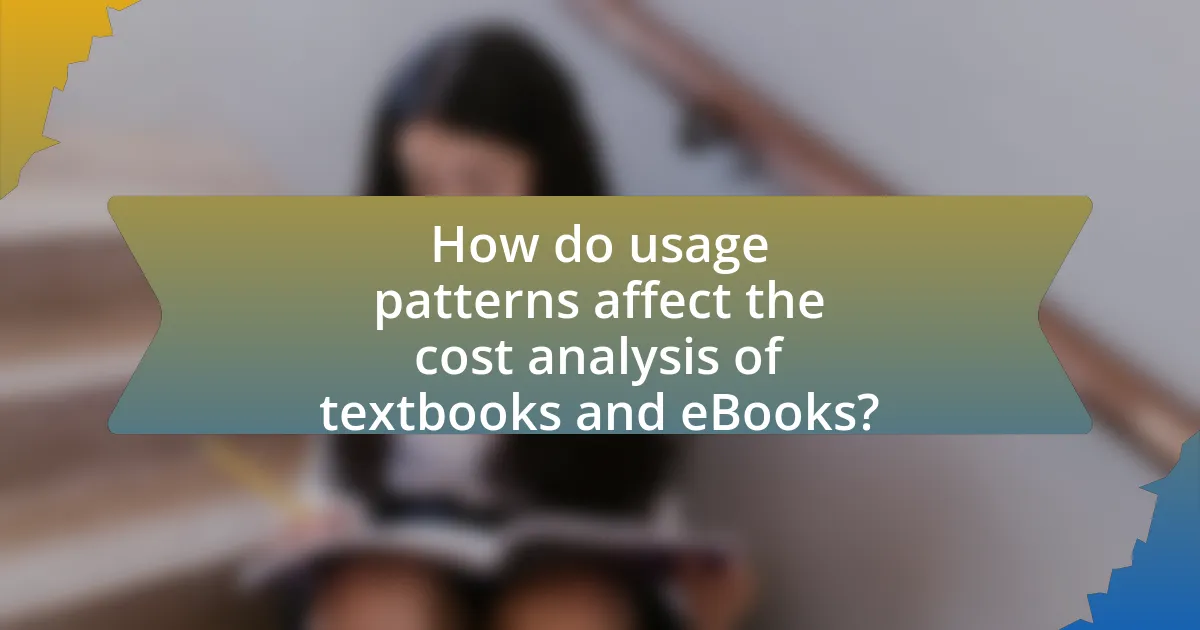
How do usage patterns affect the cost analysis of textbooks and eBooks?
Usage patterns significantly influence the cost analysis of textbooks and eBooks by determining the frequency and duration of use, which directly impacts overall expenses. For instance, eBooks often have lower upfront costs compared to traditional textbooks, but their value is maximized when used frequently, as subscription models or licensing fees can accumulate over time. A study by the National Association of College Stores found that students who frequently use eBooks save an average of 30% on course materials compared to those who rely on traditional textbooks, highlighting how usage patterns can lead to substantial cost differences. Additionally, the ability to access eBooks across multiple devices increases their utility, further justifying their cost in a comprehensive analysis.
What are the typical usage rates for traditional textbooks versus eBooks?
Traditional textbooks are used by approximately 70% of students, while eBooks account for about 30% of usage in educational settings. This disparity reflects a preference for physical books, which many students find easier to navigate and annotate. According to a study by the National Center for Education Statistics, 65% of college students reported using traditional textbooks in their courses, compared to 25% who utilized eBooks. This data indicates a significant reliance on traditional formats despite the growing availability of digital alternatives.
How does the frequency of use impact the overall cost-effectiveness?
The frequency of use significantly enhances the overall cost-effectiveness of eBooks compared to traditional textbooks. When eBooks are utilized frequently, the cost per use decreases, making them more economical over time. For instance, if a student purchases a traditional textbook for $100 and uses it for one semester, the cost per use is $100. In contrast, if an eBook costs $30 and is used across multiple semesters or by multiple students, the cost per use can drop to as low as $10 or less, depending on the number of users and duration of use. This demonstrates that higher frequency of use directly correlates with lower costs per use, thereby increasing the cost-effectiveness of eBooks in educational settings.
What are the implications of sharing and borrowing on costs?
Sharing and borrowing significantly reduce costs associated with acquiring educational materials. When students share textbooks or borrow them from libraries, they avoid the full purchase price, which can range from $100 to $300 per book. This practice not only alleviates financial burdens on students but also promotes resource efficiency, as fewer new books need to be printed. According to a study by the National Association of College Stores, students can save an average of 50% on textbook costs through sharing and borrowing. Thus, the implications of these practices lead to lower overall expenses for students and a more sustainable approach to educational resources.
How do student preferences influence the cost analysis?
Student preferences significantly influence cost analysis by determining the demand for traditional textbooks versus eBooks. When students show a strong preference for eBooks due to factors like lower prices, convenience, and accessibility, publishers and educational institutions may adjust their pricing strategies accordingly. For instance, a study by the National Association of College Stores found that students preferred eBooks 60% of the time, leading to a shift in market focus towards digital formats, which can reduce overall costs for institutions and students alike. This shift in preference directly impacts the cost analysis by highlighting the need for cost-effective solutions that align with student choices, ultimately influencing pricing models and resource allocation in educational settings.
What are the reasons students prefer one format over the other?
Students prefer eBooks over traditional textbooks primarily due to their cost-effectiveness and convenience. eBooks are often less expensive than printed textbooks, which can significantly reduce students’ overall educational expenses. According to a study by the National Association of College Stores, eBooks can be up to 60% cheaper than their physical counterparts. Additionally, eBooks offer features such as searchability, portability, and adjustable text sizes, enhancing the learning experience. These factors contribute to a growing preference for digital formats among students, as they align with modern technological trends and learning habits.
How do preferences affect the overall market for textbooks and eBooks?
Preferences significantly influence the overall market for textbooks and eBooks by determining consumer demand and purchasing behavior. For instance, a growing preference for digital formats has led to an increase in eBook sales, which accounted for approximately 20% of the textbook market in 2022, according to the Association of American Publishers. This shift is driven by factors such as convenience, accessibility, and often lower costs associated with eBooks compared to traditional textbooks. As preferences evolve, publishers adapt their offerings, resulting in a dynamic market that reflects the changing needs and desires of students and educators.
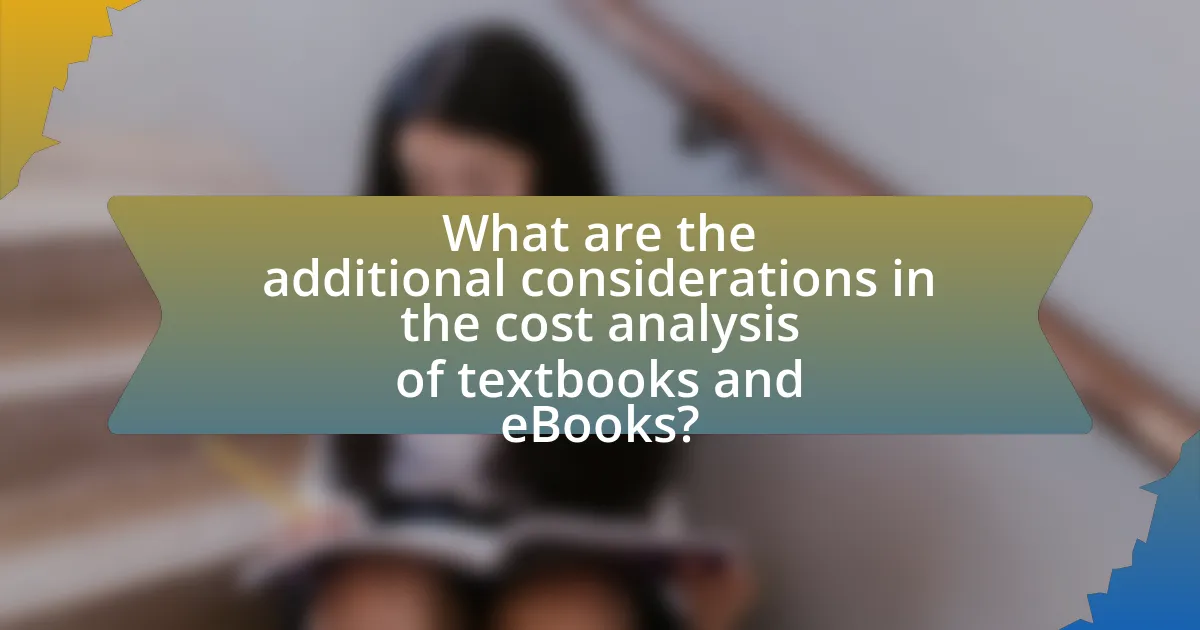
What are the additional considerations in the cost analysis of textbooks and eBooks?
The additional considerations in the cost analysis of textbooks and eBooks include factors such as long-term access, resale value, and supplementary costs. Traditional textbooks often have a resale value that can offset initial costs, while eBooks typically do not allow resale, impacting their overall value proposition. Furthermore, eBooks may require specific devices or software, leading to additional expenses for students. According to a study by the National Association of College Stores, the average cost of a new textbook is around $100, while eBooks can range from $30 to $80, but the total cost of ownership must also consider access duration and potential updates.
How do accessibility and convenience factor into the cost analysis?
Accessibility and convenience significantly influence cost analysis by affecting the overall value proposition of traditional textbooks versus eBooks. eBooks often provide instant access and portability, reducing the need for physical storage and transportation costs associated with traditional textbooks. For instance, a study by the National Association of College Stores found that students save an average of 50% on textbook costs when opting for digital formats, which highlights the financial benefits of accessibility. Additionally, the convenience of accessing eBooks on multiple devices allows for enhanced learning opportunities, further justifying their cost-effectiveness compared to traditional textbooks.
What are the accessibility features of traditional textbooks?
Traditional textbooks offer several accessibility features, including tactile formats, large print options, and braille editions for visually impaired readers. These features ensure that individuals with different needs can engage with the content effectively. For instance, large print editions are specifically designed to enhance readability for those with low vision, while braille editions provide essential access for blind students. Additionally, traditional textbooks often include clear layouts and structured content, which can aid comprehension for learners with cognitive disabilities. These accessibility features are crucial in promoting inclusive education and ensuring that all students have equal opportunities to learn.
What accessibility advantages do eBooks offer?
eBooks offer significant accessibility advantages, including adjustable font sizes, text-to-speech capabilities, and compatibility with screen readers. These features enable users with visual impairments or reading difficulties to customize their reading experience, enhancing comprehension and engagement. For instance, studies show that eBooks can improve reading speed and comprehension for individuals with dyslexia due to their customizable formats. Additionally, eBooks can be accessed on various devices, allowing users to read anytime and anywhere, which is particularly beneficial for those with mobility challenges.
What are the environmental costs associated with each format?
Traditional textbooks incur significant environmental costs primarily due to paper production, which involves deforestation, water consumption, and energy use. The production of one ton of paper requires approximately 24,000 gallons of water and results in the emission of about 1.5 tons of carbon dioxide. In contrast, eBooks have lower direct environmental costs related to paper but involve electronic waste and energy consumption during device manufacturing and usage. The production of an e-reader can generate up to 100 kg of CO2 emissions, and the energy required to charge devices contributes to their overall environmental footprint. Thus, while eBooks reduce paper waste, they still pose environmental challenges through electronic waste and energy consumption.
How does the production of traditional textbooks impact the environment?
The production of traditional textbooks significantly impacts the environment through deforestation, energy consumption, and waste generation. The process typically involves cutting down trees for paper, contributing to habitat loss and increased carbon emissions. For instance, producing one ton of paper requires approximately 24,000 gallons of water and results in the release of 1.5 tons of carbon dioxide. Additionally, the manufacturing process consumes substantial energy, with estimates suggesting that the paper industry accounts for about 4% of global greenhouse gas emissions. Furthermore, traditional textbooks often end up in landfills, where they contribute to waste and pollution, as they are not easily recyclable due to the binding and printing processes used.
What is the environmental footprint of eBooks?
The environmental footprint of eBooks is significantly lower than that of traditional printed books. eBooks eliminate the need for paper, ink, and physical transportation, which reduces deforestation and carbon emissions associated with book production and distribution. A study by the University of California, Berkeley, found that reading an eBook can save approximately 1.5 pounds of carbon dioxide emissions compared to reading a printed book, considering the entire lifecycle from production to disposal. Additionally, eBooks require less energy to produce and distribute, further minimizing their environmental impact.
What best practices should students consider when choosing between traditional textbooks and eBooks?
Students should consider factors such as cost, accessibility, and study preferences when choosing between traditional textbooks and eBooks. Traditional textbooks often have a higher upfront cost, averaging around $100 per book, while eBooks can be significantly cheaper, sometimes costing 30-50% less. Accessibility is another critical factor; eBooks can be accessed on multiple devices, allowing for easier portability and searchability, which can enhance study efficiency. Additionally, students should evaluate their learning styles; some may prefer the tactile experience of physical books, while others may benefit from the interactive features of eBooks, such as hyperlinks and multimedia content. Research indicates that 70% of students prefer eBooks for their convenience and lower cost, supporting the trend towards digital learning materials.


